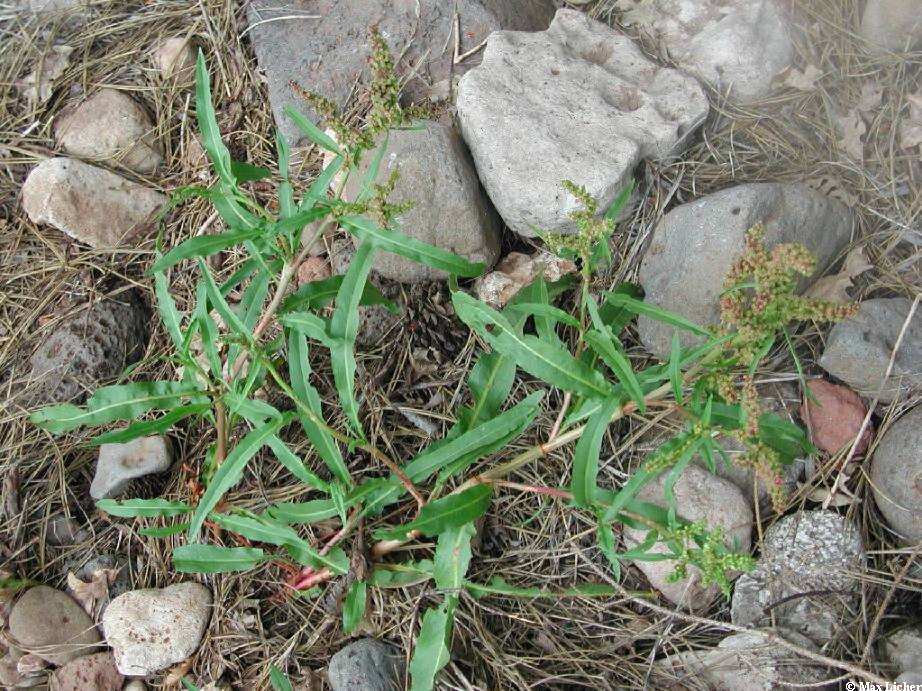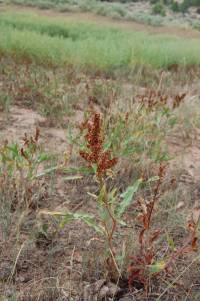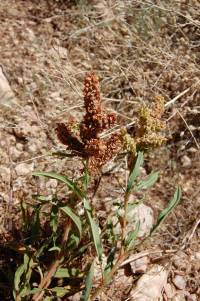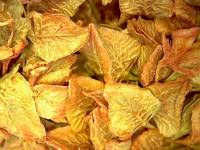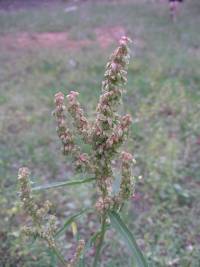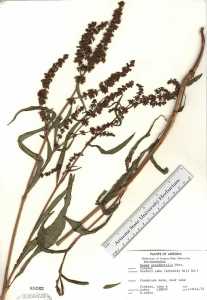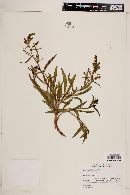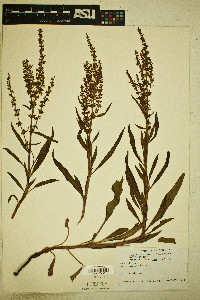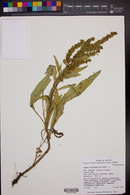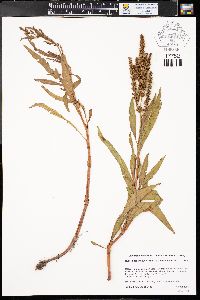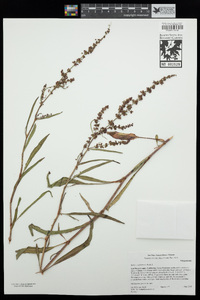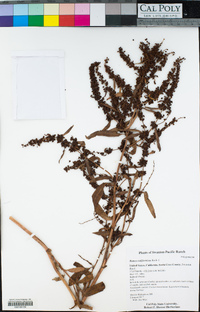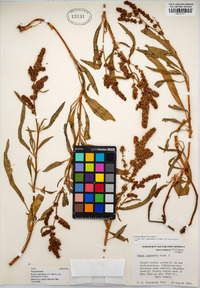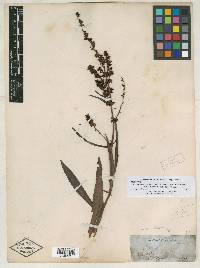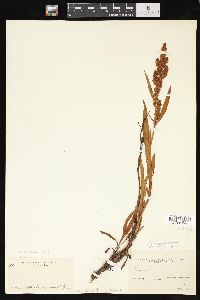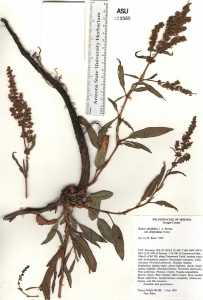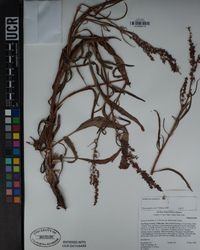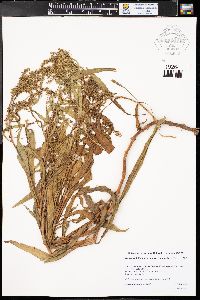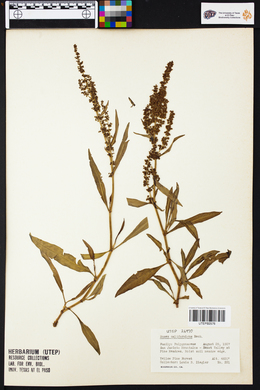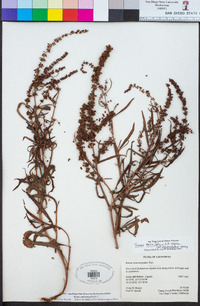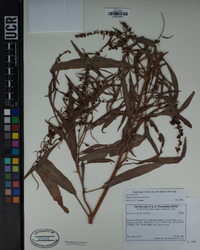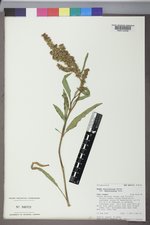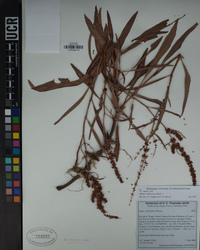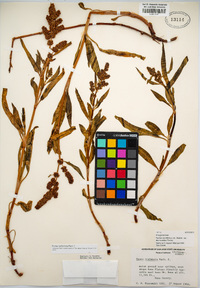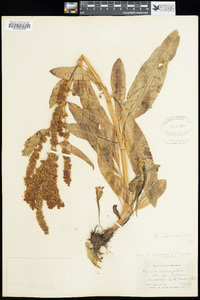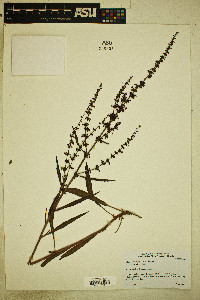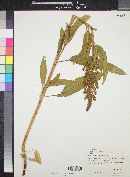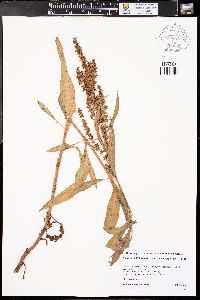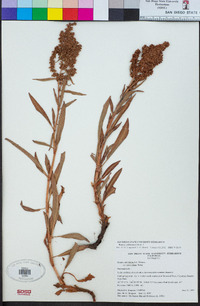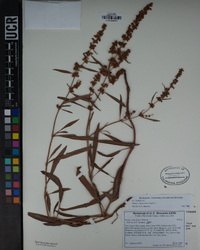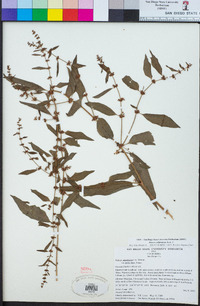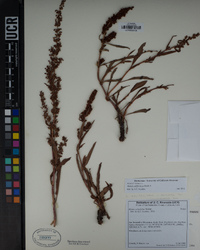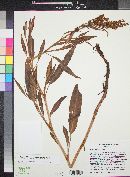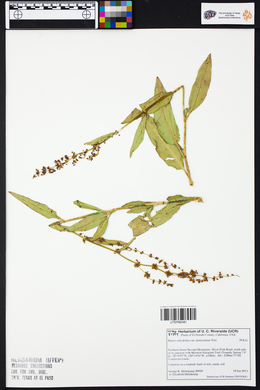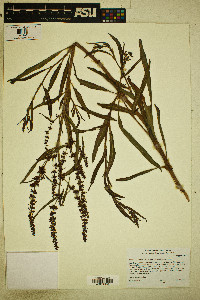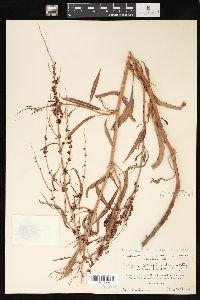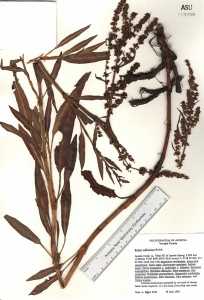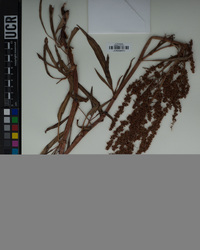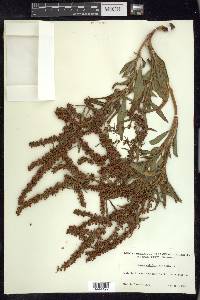
|
|
|
|
Family: Polygonaceae
California Willow Dock, more...toothed willow dock
[Rumex salicifolius var. denticulatus Torr.] |
Plants perennial, glabrous, with vertical rootstock. Stems usually ascending, rarely decumbent-ascending or suberect, usually producing axillary shoots below 1st-order inflorescence or at proximal nodes, 30-60 cm. Leaf blades linear-lanceolate or linear-oblanceolate, 5-10 × 1-3 cm, usually ca. (3-)5-7 times as long as wide, usually widest near middle, thin or, occasionally, subcoriaceous, base cuneate, margins entire, flat or, occasionally, undulate near base, apex acute or attenuate. Inflorescences terminal and axillary, terminal usually occupying distal 5- 3 of stem, lax, interrupted at least in proximal 1/2, usually broadly paniculate (branches simple or with few 2d-order branches). Pedicels articulated in proximal 1/ 3 or almost near base, filiform, 3-8 mm, not more than 2-2.5 times as long as inner tepals, articulation indistinctly swollen. Flowers 10-15(-20) in whorls; inner tepals usually broadly triangular or deltoid, 2.5-3.5 × 2.2-3.3 mm, base truncate, margins minutely but distinctly denticulate, rarely subentire, apex obtuse or subacute; tubercles absent, or only 1 midvein slightly swollen. Achenes brown or dark reddish brown, 2 × 1.3 mm. 2n = 20. Flowering late spring-summer. Moist coastal, alluvial, and montane habitats; 0-3000 m; Ariz., Calif., Nev., Oreg.; possibly n Mexico. Rumex californicus is closely related to and often is regarded as a variety of R. salicifolius. In Oregon this species has been reported only as a ballast waif in the Albina neighborhood of Portland (K. H. Rechinger 1937). It has been reported also from northeastern Nevada (J. T. Kartesz 1987, vol. 1), New Mexico (W. C. Martin and C. R. Hutchins 1980), and Wyoming (N. M. Sarkar 1958), but these records require confirmation.
General: Perennial, 30-60 cm tall; stems usually ascending, usually producing axillary shoots below the inflorescence or at the lower nodes; herbage glabrous; taprooted. Leaves: Basal and cauline, alternate, blades lanceolate or linear-lanceolate, 5-10 cm long, 1-3 cm wide, widest near middle, thin to occasionally somewhat leathery, glabrous, margins entire, occasionally wavy near the base, base wedge-shaped, apex acute to attenuate; ocrea membranous, brownish; basal and lower cauline blades petiolate, upper cauline blades sessile. Flowers: Staminate and pistillate flowers on separate plants (dioecious); inflorescence terminal, panicle-like, broadly or narrowly so; pedicels filiform, 1-3 mm long; flowers 3-10, arranged in whorls; perianth campanulate, green, pink, or red, the inner tepals not or only slightly enlarged, 1.2-2 mm long; tubercle absent; flowers May-September. Fruits: Achene, 2 mm long, brown to dark reddish brown. Ecology: Pinyon-juniper woodlands, ponderosa pine forests, springs, montane habitats; 300-2700 m (1000-9000 ft); Apache, Coconino, Maricopa, and Yavapai counties; western U.S., possibly Mexico. Notes: Rumex triangulivalvis (Mexican dock) [=R. mexicanus, R. salicifolius var. mexicanus] is very similar, but can be distinguished by its generally taller stature (up to 100 cm) and longer leaves (up to 17 cm); inner tepals have entire or indistinctly dentate margins, and usually bear 3 narrow tubercles. It is found in disturbed sites, meadows, and wet habitats. Rumex salicifolius (willow dock) is also very similar, but is differentiated by having inner tepals approximately 2-2.5 mm long, these bearing 1 large tubercle, either sub-equal to inner tepals or slightly narrower (then free margins of inner tepal distinctly narrower than the tubercle). It occurs along rivers and streams, in wet mountain meadows, and on rocky slopes. Rumex altissimus (tall dock, pale dock) is distinguished by ovate-lanceolate or elliptic-lanceolate leaves, these distinctly widest in the lower half; inner tepals are 4.5-6 mm long; and tubercles are usually 3, equal or nearly so, glabrous or minutely wrinkled. It occurs along streams, lakes, marshes, and other wet habitats. Editor: Springer et al. 2008 |
This project was made possible in part by the Institute of Museum and Library Services [MG-70-19-0057-19].
Powered by Symbiota

